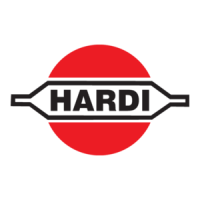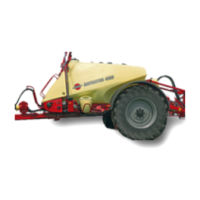42 HARDI
®
NAVIGATOR 550M, 800M, 1000M CENTRIFUGAL OPERATOR'S MANUAL
5.0 MAINTENANCE
IMPORTANT:
Always clean the boom at the end of your workday
or
before servicing is done to avoid unnecessary contact with
chem icals.
In order to derive full benefi t from the sprayer for many years, the following
service and maintenance program should be followed.
5.1 Cleaning The Sprayer
Guidelines
Read the whole chemical label. Take note of any particular instructions
regarding recommended protective clothing, deactivating agents, etc. Read
the detergent and deactivating agent labels. If cleaning procedures are
given, follow them closely.
Be familiar with local legislation regarding disposal of pesticides washings,
mandatory decontamination methods, etc. Contact the appropriate
department, e.g. Dept. of Agriculture.
Pesticide washings can usually be sprayed out on a soakaway. This is an
area of ground that is not used for cropping. You must avoid seepage or
runoff of residue into streams, water courses, ditches, wells, springs, etc.
The washings from the cleaning area must not enter sewers. Drainage
must lead to an approved soakaway.
Cleaning starts with the calibration, as a well calibrated sprayer will ensure
the minimal amount of remaining spray liquid.
It is good practice to clean the sprayer immediately after use, thereby
rendering the sprayer safe and ready for the next pesticide application.
This also prolongs the life of the components.
It is sometimes necessary to leave spray liquid in the tank for short periods,
e.g. overnight, or until the weather becomes suitable for spraying again.
Unauthorized persons and animals must not have access to the sprayer
under these circumstances.
If the product applied is corrosive, it is recommended to coat all metal
parts of the sprayer before and after use with a suitable rust inhibitor.
Remember: Clean sprayers are safe sprayers.
Clean sprayers are ready for action.
Clean sprayers can not be damaged by pesticides and their
solvents.
